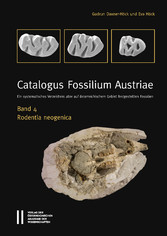Search and Find
Service
Catalogus Fossilium Austriae Band 4: Rodentia neogenica - Ein systematisches Verzeichnis aller auf österreichischem Gebiet festgestellten Fossilien
More of the content

Catalogus Fossilium Austriae Band 4: Rodentia neogenica - Ein systematisches Verzeichnis aller auf österreichischem Gebiet festgestellten Fossilien
Der Band 'Rodentia neogenica' des Catalogus Fossilium Austriae vermittelt einen Überblick über Rodentia aus dem Neogen von Österreich und spiegelt ein faszinierendes Kapitel der Säugetierevolution. Die bearbeiteten Fossilien wurden an 34 Fundstellen gesammelt, die einen Zeitraum von etwa elf Millionen Jahren umfassen. Maigen ist die älteste und Eichkogel die jüngste Fundstelle. Die österreichischen Kleinsäugetierfundstellen liegen im Alpenvorland, im Wiener Becken, im Steirischen Becken und seinen Satellitenbecken, im Pannonischen Becken, im Mur-Mürz- und im Lavanttal. Der gesamte Fossilienkomplex umfasst Kiefer und Schädel von Säugetieren und mehrere tausend isolierte Zähne, die zum größten Teil im Naturhistorischen Museum Wien (Geologisch-Paläontologische Abteilung) aufbewahrt werden, kleinere Teile in der Universität Wien (Paläontologische Abteilung), im Universalmuseum Graz (Geologie & Paläontologie), an der Montanuniversität Leoben und in Privatsammlungen. Der vorliegende Band bietet eine Einführung in Taxonomie, Systematik und Stratigraphie aller Nagergruppen, die im Miozän in Österreich lebten. Eine Übersichtskarte von Österreich und eine stratigraphische Tabelle zeigen die regionale und stratigraphische Lage der Fundstellen. Die Terminologie der Zahnmerkmale wird anhand von 22 schematischen Darstellungen erklärt, und auf 77 Tafeln illustrieren SEM-Bilder die Variabilität der Zahnmorphologie von über 50 Gattungen und 90 Arten. Der Band schließt mit einem taxonomischen Index. *** The present volume Rodentia neogenica of the Catalogus Fossilium Austriae provides an overview of Neogene rodents from Austria, reflecting a fascinating chapter of mammal evolution. The investigated fossils were collected from 34 localities spanning a time interval of around eleven million years from the early to the late Miocene, with Maigen being the oldest and Eichkogel the youngest fossil site. The small mammal localities are situated in Neogene sedimentary basins of Austria: the Northern Alpine Foreland Basin, the Vienna Basin, the Styrian Basin and its satellite basins, the Pannonian Basin, and smaller basins along the Mur-Mürz and the Lavant Valley. The investigated rodent fossils comprise thousands of isolated teeth, jaws and some partial skulls. They are housed in the collections of the Museum of Natural History Vienna (Geological-Paleontological Department). Minor parts stem from collections of the University of Vienna (Department of Palaeontology), the Universalmuseum Joanneum Graz (Geology & Palaeontology), the Montanuniversität Leoben, and some private collections. The present volume introduces taxonomy, systematics and stratigraphy of all rodent groups represented in the Miocene of Austria. A sketch map of Austria and a stratigraphic chart show the topographic and stratigraphic positions of the fossil sites. The dental terminology is explained using sketches of dental patterns (22 Figs). SEM images illustrate the morphologic variation of dental characters of more than 50 represented genera and 90 species (77 Plates). The volume is completed by a taxonomic index.
All prices incl. VAT










